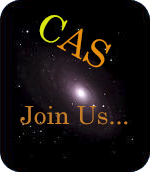Klaus
Yes
A Brief History of Lunar Exploration: Part I
by Klaus Brasch
And if she faintly glimmers here,
And paled is her light,
Yet alway in her proper sphere
She’s mistress of the night.
From The Moon Poem by Henry David Thoreau
Introduction
An advantage of reaching one’s 75th birthday is the realization that you are now part of history. To that end, I count myself fortunate to have experienced a time when night skies were still quite dark even in big cities. I was ten years old in 1951, when my father led me to the roof of my grandparents’ house in Rome, Italy, and showed me the Moon through an old brass telescope. Seeing craters, mountains, and dull grey features termed Maria, all in sharp contrast, jolted me into the realization that I was seeing another world in space and engendered an awareness of the beauty of the cosmos that has lasted a lifetime. Later, I was given a book titled La Luna (Fresa, 1943), which I still have, filled with drawings, facts, and photographs about and of the Moon. While mostly beyond my comprehension at the time, this book showed that studying the natural world was a legitimate and fun thing to do, and set me on my course of becoming a scientist.
The history of lunar explorations through the ages has been documented by a number of authors (see e.g. Kopal and Carder, 1974; Moore, 1963; Sheehan and Dobbins, 2001), most of these works are dated, very technical or deeply scholarly, and not really aimed at today’s amateur observer. This essay will hopefully meet that need.
From Antiquity to the Telescope
It’s safe to say that besides the Sun, the Moon has been the most influential celestial object in human affairs. Wikipedia (2015a) lists no less than 70 lunar deities, spanning various continents, cultures, and mythologies. Not surprisingly, the monthly lunar cycle has been linked with human menses and fecundity in many cultures and consequently associated with female deities like Selene in Greco-Roman mythology and the Chinese goddess Chang’e (Figure 1). Others, however, favoured male lunar deities, including Sin in Mesopotamia and Tsukuyomi in Shintoism.
The Moon has given rise to many myths and superstitions, as well as some positive omens, in both ancient and modern times. Lunar eclipses have been particularly maligned, conjuring visions of demons and ravenous animals. The Incas, for example, believed that an eclipse was due to a jaguar devouring the Moon and then crashing to Earth to feast on humans (Lee, 2014). In ancient China, the Moon was perceived as a mirror and that dragons swallowed it during an eclipse. People would beat on mirrors during such events, causing the dragon to release the Moon once again. In western history, the term lunatic, from the Latin Luna or moon, has been widely associated with aberrant human and animal behaviour. Madness and werewolves—among other myths were linked by ancient Greeks to the phases of the Moon because, they reasoned, since our orb influences ocean tides, it was likely to affect the human brain as well. These ideas persisted well into the 17th and 18th centuries in European folklore and elsewhere. Indeed, even today, it is still commonly believed that the Moon influences the weather, the times for crop planting and harvesting, and recently the so-called super Moon, an astrological rather than astronomical term, regularly appears on Internet sites. For more The Moon in our Imagination, see Hockey (1986).
The Moon also plays a pivotal role in Judaism (Wikipedia, 2015b). Rosh Chodesh or Beginning of the Month; lit. Head of the Month, is the name for the first day of every month in the Hebrew calendar, and is marked by the new Moon. Based on the book of Exodus, this established the beginning of the Hebrew calendar and in Psalm 81:4 both the new and full Moon are mentioned as a time of awareness.
While the Quran clearly emphasizes that the Moon is a sign of God, not a deity itself, it plays a significant role in Islamic religion, which also uses a lunar calendar. The crescent Moon, called Hilal, defines the start and end of the Islamic month, and determining the precise time of Hilal is crucial to specifying the date of Ramadan, a most important time of atonement. This was one of the reasons early Muslim scholars studied astronomy (Wikipedia, 2015c).

Figure 1 — From left: Selene, Chang’e, and Sin (All wikicommons)
December / décembre 2015 JRASC | Promoting Astronomy in Canada 251
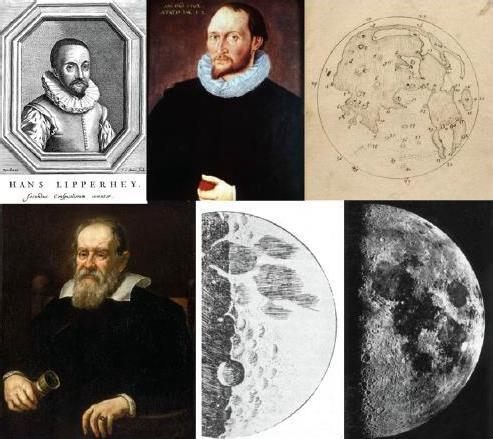
Figure 2 — Top: Hans Lippershey (1570–1610); Thomas Harriot (1560–1621) & his Moon chart. Bottom: Galileo Galilei (1564–1642) (Justus Susterman); Galileo’s sketch of the Moon with comparable photograph (All images wikicommons)
The realization that the Moon might be another world or planet like the Earth can be traced back to earliest literature in both western and eastern cultures. In the 2nd century AD, for example, Lucian of Samosata wrote a parody titled True Story about travel to another world with alien inhabitants. Likewise a 10th-century Japanese folk tale titled The Tale of the Bamboo Cutter, also involves travel to the Moon, which is inhabited. After invention of the telescope in the early 1600s, speculation as to the nature and composition of the Moon reached a more Earth-centred perspective with references to Maria or seas to the large dark lunar features and to mountains like the lunar Alps and Apennines. Belief in the possibility that our nearest neighbour might be inhabited also reached a new high, as exemplified in the 1638 book by English astronomer John Wilkins titled: The Discovery of a World in the Moone or, a discourse tending to prove that ’tis probable there may be another habitable world in that planet.
By the 19th century, when our understanding of the Moon as a planetary-sized body with its own distinct geology and orbital characteristics had advanced significantly, “hard” science fiction stories began to appear, instead of just fantasy voyages involving magic or gods. Notable among these are From the Earth to the Moon (1865) and its sequel, Around the Moon (1870), both by the remarkably futuristic French author Jules Verne. This was followed in 1901 by the H.G. Wells classic, First Men in the Moon, in which travel to our satellite, inhabited by insect-like Selenites, is accomplished via an anti-gravity machine. With advances in rocket science during the early 20th century, more hard science fiction followed, including the remarkably realistic 1950 movie, Destination Moon, a fitting prelude to the soon-to-follow space race, and culminating in 1968 with the Arthur C. Clark novel and Stanley Kubrick classic movie, 2001: A Space Odyssey. This epic saga coincided with the Apollo missions and provided not only a credible backdrop to manned exploration of the Solar System, but also a tantalizing prologue to the real possibility that intelligent life might exist elsewhere in the Universe.
First Light
While it is clear that Galileo Galilei did not invent the telescope, a device largely attributed to Dutchman Hans Lippershey, who tried to patent it, nor was Galileo the first to use one to examine and sketch the Moon. Englishman Thomas Harriot most likely did, but the great Italian astronomer was the first to formally publish his findings (Figure 2). His Sidereus Nuncius (The Starry Messenger), published in 1610, was a testament to his scientific prowess, and placed Galileo in a pre-eminent position in the annals of cosmology (Figure 3). As astrophysicist Richard Learner puts it: “The Starry Messenger… is more a symptom of his greatness than one of its causes. His achievements rest on his immense intellectual confidence, even arrogance. He was confident enough to accept that in eight months he had accumulated sufficient evidence to reject the picture of the universe that had been built up by 2000 years of endeavor by pre-telescopic astronomers: the Book of Genesis was wrong, the philosopher Aristotle was wrong, the great Greek astronomer Ptolemy was wrong, even St Thomas Aquinas was wrong, but Galileo was not” (Learner, 1981).
Galileo’s epic discoveries and their cosmological and theological implications at the time, inevitably led him into conflict with the Catholic Church and other authorities. His defence of Heliocentrism as advocated by Copernicus, coupled with his clearly strong intellectual arrogance did not help things either. This is so diplomatically and lovingly alluded to in a letter by his daughter, Sister Maria Celeste on 1633 April 20, while Galileo was facing judgement by the Holy Office of the Inquisition (Sobel, 1999). The letter states in part “The only thing for you to do now is to guard your good spirits, taking care not to jeopardize your health with excessive worry, but to direct your thoughts and hopes to God, Who, like a tender, loving father, never abandons those who confide in Him and appeal to Him for help in time of need.”
Galileo, of course, was not the only prominent astronomer at the time to run into trouble with religious authorities. His contemporaries, Johannes Kepler, a Protestant, ran into religious persecution, and Thomas Harriot was accused of atheism even before starting his astronomical observations (Learner, 1981).
December / décembre 2015 JRASC | Promoting Astronomy in Canada 252
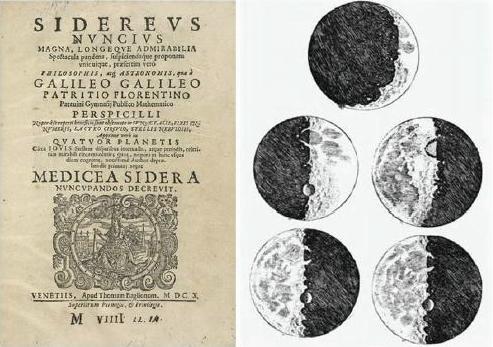
Figure 3 — Sidereus Nuncius (The Starry Messenger), published in 1610
Nonetheless, with news about the telescope, word spread quickly across Europe that the device had considerable military, commercial, and scientific uses. Although Lippershey claimed first rights, other lens makers, including Dutchman Jacob Metius and Italian Giambatista della Porta in Naples made similar claims. In all probability, once the concept of a telescope and reasonable quality lenses became available, many people no doubt put two of them together and realized their potential. Because of this, and despite objections by clergy, philosophers, and other adherents of the Ptolemaic model of the Universe, observational astronomy had opened Pandora’s Box. The Moon, Jupiter’s satellites, the phases of Venus, sunspots, and endless vistas of stars in the Milky Way, as described by Galileo, Harriot, Kepler, and many other contemporaries, gradually shook the foundations of the prevailing concepts of cosmology in favour of the Copernican model.
Although Galileo’s telescopes were probably among the best available at the time and his observing skills equal to the task, his intellectual fortitude was at the root of his many achievements (Sheehan and Dobbins, 2001). Despite the fact that some have criticized his published lunar drawings as poorly executed, lunar-mapping expert Ewen Whitaker points out that Galileo’s sketches of the Moon’s surface features at different phase angles were remarkably accurate, especially given the optical limits and extremely narrow field of view of his instruments (Whitaker, 1989). Take Figures 2 and 3 for example. As an experienced lunar observer for many decades, I have often wondered as to the precise identity of the prominent round feature depicted by Galileo in the southcentral portion of the lunar disk bisected by the terminator at both first and last quarter. The dark northern oval is clearly Mare Imbrium, but the conspicuous southern feature seems disproportionally large in size to correspond to any obvious crater or basin.
A few years ago, I was fortunate enough to observe the Moon just past first quarter through replicas of Galileo’s famous two parallel-mounted telescopes at the annual Riverside Telescope Makers conference in Big Bear, California. Their maker, a very skilled craftsman, had visited the museum in Florence, Italy, where the originals are housed and was given all specifications as to glass type, magnifications, lengths, and focal lengths of the historic instruments by the museum’s archivist. Upon returning to the US, he fashioned as exact a replica as possible of both telescopes and their mount.
It took but one glance at the first-quarter Moon through the 20-power telescope to solve the mystery of the large crater; it was most likely the great walled plain, Albategnius, as suggested by Whitaker (1989). How did we know? For one thing, the field of view of Galileo’s refractor was so narrow as to not fully encompass the entire lunar disk at once. Consequently, what is depicted as the lunar limb in some of his sketches is most likely the edge of the field of view, making Albategnius appear disproportionally large in his rendition, especially under low angles of illumination. Second, as pointed out before (Whitaker, 1989), many second-tier publications of his bestselling Sidereus Nuncius were illustrated with vastly inferior woodcut copies of his drawings and most likely not faithfully.
We also observed Jupiter that night with the replica telescopes and were astonished to see that while the Jovian disk was just a dazzling, multi-colored blob; the Galilean moons were clearly visible. I think all who looked through those telescopes that evening came away with a new sense that Galileo’s observations some four centuries ago were not only remarkable in themselves, but that his essentially correct interpretations of what he saw are among the most astute in the history of science.
Early Telescopic Studies
Like many advances in astronomy, the study of the Moon progressed in parallel with improvement in telescope and eyepiece designs. The extremely narrow field of view and optical aberrations of the Galilean design were improved considerably in 1611 through modifications introduced by Johannes Kepler. This design used a convex lens as eyepiece in place of a concave one, allowing for a much wider field of view and greater eye relief (Figure 4). Although the resulting image is inverted, this combination provided considerably higher magnification as well (Wikipedia, 2015d). Severe chromatic aberration was still a problem though, which could be minimized by using simple objective lenses of very high f-ratios (Learner, 1981); an approach carried to extremes by Johannes Hevelius’s 150-foot-long “aerial” or “tubeless telescope,” and even longer designs by others (Figure 4).
Despite the many limitations of both Galilean and Keplerian type telescopes, a number of observers produced remarkably good early lunar maps. This can be attributed to several factors. The rapid proliferation of optical devices, coupled with curiosity about the true nature of our satellite, likely led to a competition to be the first to make new discoveries and attach names to lunar features; the equivalent of the first Moon-race (Sheehan and Dobbins, 2001). For instance, between 1609 and 1679, at least a dozen known Moon maps were produced of varying degrees of accuracy and with a plethora of different feature names. For complete coverage of this period of lunar cartography see: Kopal and Carder (1981); Chapter 1, and Whitaker (1989).
December / décembre 2015 JRASC | Promoting Astronomy in Canada 253
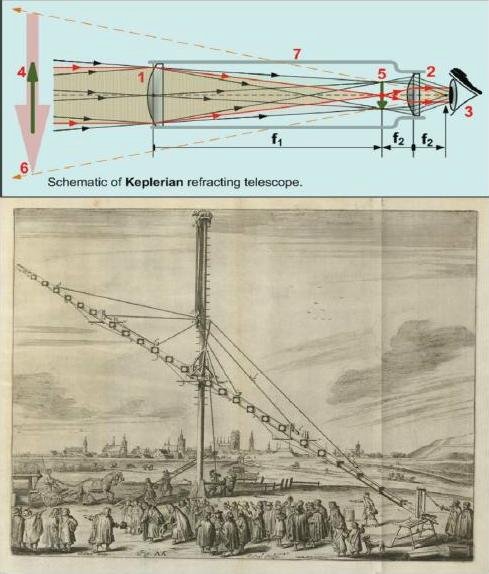
Figure 4 — Top: Keplerian modification of the Galilean telescope, providing better eye relief, higher magnification, wider field of view, and an inverted image. Bottom: Woodcut of Johannes Hevelius’s unwieldy “aerial telescope” in Danzig ca. 1667.
The developmental history of lunar exploration can be grouped into several phases (Ré, 2014). The pre-telescopic era most likely began in 450 BC with the speculations by the remarkable Greek philosopher Democritus, that the Moon contained mountains and valleys, and ended in 1603 with English physician William Gilbert’s discovery of lunar libration and his quite accurate naked-eye map of the full Moon. The birth of selenography, however, the detailed study of the surface and physical features of the Moon, began with the invention of the telescope. The first mapping efforts by Galileo and Harriot were quickly followed by more systematic attempts by Michel van Langren (better known as Langrenus) in 1645, Johannes Hevelius in 1647, and Giovanni Riccioli in 1651, with a little help from his Jesuit colleague Francesco Grimaldi (Figure 5). All three of these early maps included nomenclatures of various lunar features, many honouring prominent Catholic figures in the Langrenus map and terrestrial land features by Hevelius. Many of these names were subsequently abandoned except those assigned by Riccioli, most of which gained gradual acceptance and survive to this day.
Two other major players to enter the astronomical scene in the mid to late 1600s were Dutchman Christiaan Huygens (1629-1690) and Italian Giovanni Cassini (1625-1712) (Figure 6). Equipped with much improved Keplerian-style telescopes, these two giants of observational astronomy made some seminal discoveries, both in their respective native countries and in France at the invitation of King Louis XIV.
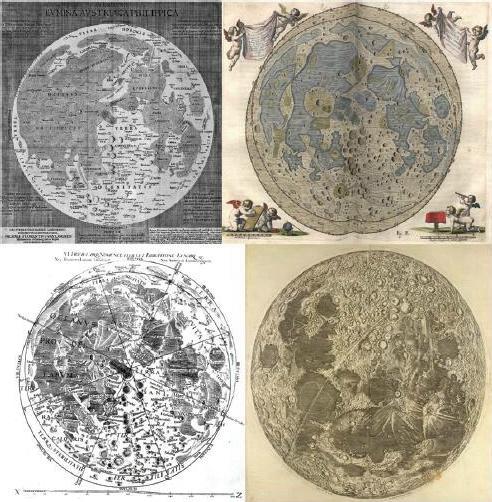
Figure 5 — Top left: Langrenus (1645), right: Hevelius (1647) Bottom left: Riccioli & Grimaldi, right: Cassini (ca. 1680)
Huygens optimized telescope design in two important ways. He and his brother Constantijn improved lens grinding and polishing methods, and by combining two plano-convex lenses, produced the first compound eyepiece with superior eye-relief and well suited to the very long focal-length-telescopes of the times (Learner, 1981; Wikipedia, 2015e). In addition, the Huygens brothers tried to better control these unwieldy instruments and accommodate their very long focal-length objectives by eliminating the tube altogether. In these “aerial” instruments, the objective lens was mounted inside a short iron tube, which in turn was mounted on a swivelling ball-joint on top of an adjustable mast. The eyepiece was placed in another shorter tube and the two were kept in alignment via a taut connecting string (digiplanet.com).
With such much-improved optics, Christiaan Huygens went on to discover the true shape of Saturn’s rings, as well as its main satellite Titan around 1655. He also made some of the earliest observations and sketches of the Orion Nebula. Though not principally a lunar observer, he nonetheless left his mark there too, by being first to record such features as the Straight Wall, the Huyginus Cleft, and the later-named Schroeter’s Valley (Sheehan and Dobbins, 2001).
December / décembre 2015 JRASC | Promoting Astronomy in Canada 254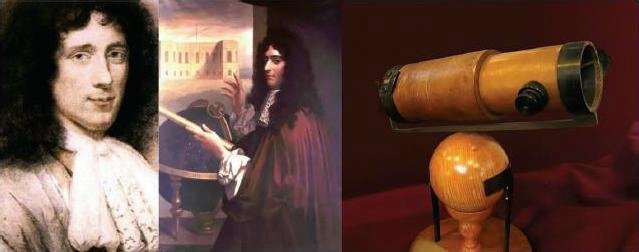
Figure 6 — From left: C. Huygens, G. Cassini, replica of Newton’s telescope (all wikicommons and public domain)
Huygens’s contemporary, Giovanni Cassini, began his prodigious astronomical career in 1650 at the University of Bologna, where he determined the rotational period of Mars as 24 hrs 40 min, very close to the modern value of 24 hrs 37 min, and generated accurate tables of Jupiter’s moons. Based on this work, he was subsequently recruited to Paris Observatory in 1669, where he spent the remainder of his life (Sci.ESA, 1999) [Ed. Giovanni Domenico Cassini became Jean-Dominique Cassini after he moved to Paris]. Also using the improved very long telescopes, he accumulated an impressive list of discoveries. These included surface markings on Mars, the rotation period of Jupiter, and the main division in Saturn’s rings that still bears his name. Between 1671 and 1684, he furthermore discovered four more Saturnian moons, Iapetus, Rhea, Tethys, and Dione (Learner, 1981; Wikipedia 2015f).
Cassini was also a very accomplished lunar observer. At Paris Observatory, he established new standards in lunar cartography, stemming no doubt from his interest in terrestrial longitude determinations and map making. He made many drawings of lunar features in different phases, which he then combined into a 12-foot diameter chart (Ré) (Figure 5). This map overshadowed essentially all previous efforts with respect to details and positional accuracy (Kopal and Carder, 1971). However, as was the case with most lunar observers then, there was much personal interpretation and poetic license in the depiction of individual features, particularly due to the notion that the large dark regions of the Moon were actual seas. A good example of that is Cassini’s portrayal of the Heracleides Promontorium at the southern tip of Sinus Iridium, which to him looked like a lady’s head and the surface of the Sinus itself as almost wave-like (Sheehan and Dobbins, 2001, p. 31). The ultimate result of that is that many of the early lunar maps lacked accuracy and favoured artistic or aesthetic qualities over precision (Whitaker, 1989).
Most early lunar charts also lacked positional accuracy due to the vagaries of our satellite’s orbital characteristics, most notably longitudinal and latitudinal libration. It was known from the observations by Gilbert in 1603 that the Moon appeared to rock slightly both from side to side and up and down as it circled the Earth, thereby revealing peripheral detail to terrestrial observers. This was fully illustrated on the charts by both Hevelius and Riccioli, making it very difficult to establish accurate selenographical coordinates. That in turn, proved problematic in early attempts by French scientist Pierre Gassendi (1592-1655) and others to calculate terrestrial longitudes by timing passage of major lunar structures through the Earth’s shadow during eclipses. Finally in 1693, after decades of effort by several observers, including Hevelius, Langrenus, French mathematician Philippe de la Hire (1640–1718), and even Isaac Newton (1642–1727), to explain lunar libration, Cassini revealed the exact laws of the Moon’s rotation (Sheehan and Dobbins, 2001).
The era of long and aerial telescopes probably reached its peak with the work of Philippe de La Hire, artist, mathematician, and astronomer. He became part of a circle of French scientists and intellectuals that included Cassini, Huygens, René Descartes, and others (Wikipedia, 2015g). Among many astronomical achievements, he published an artistically superior map of the Moon, and calculated accurate tables of the movements of the Sun, Moon, and planets, as well as determining coordinates of the French coastline and the Paris meridian.
Although nearly a half-century would pass before it came into its own, the reflecting telescope was invented by Isaac Newton, with a working model unveiled in 1668 (Figure 6). It had many advantages over the very long and cumbersome non-achromatic refractors of the era (Learner, 1981). These included: colour-free optics, much shorter and compact design, and a generally wider field of view. However, Newton’s design suffered from spherical aberration and his speculum (tin and copper alloy) mirrors were subject to rapid tarnishing. Although John Hadley greatly improved optical performance of Newtonian reflectors in 1721 through use of parabolic mirrors, the limitations of speculum remained.
Scientific Lunar Cartography
After a long hiatus, the next significant phase in lunar map making began in the mid-18th century with Johann Tobias Mayer (1723–1762) (Figure 7), and with development of the achromatic refractor and the filar micrometer (Kopal and Carder, 1974; Learner, 1981). In many ways, Mayer was the father of scientific lunar cartography, since, like Langren a century before him, he was determined to establish accurate lunar longitudes using the times of entry of different features into the Earth’s shadow during a total eclipse. By using the crater Manilius as central point of his system of coordinates, Mayer used a glass micrometer to measure the positions of several other lunar features (Sheehan and Dobbins, 2001). In this fashion, he generated two maps in orthographic projection (Figure 7). This remarkable work, as Apollo-era Moon experts Kopal and Carder (1974) observed, places him in a unique position in lunar cartography: “….Tobias Mayer became not only the first modern selenographer of the world, but also the founder of the German school of selenography which in the century to come “took” the Moon away from the French and Italians, and which included Schröter, Lohrmann, Mädler, Schmidt, and Fauth.”
December / décembre 2015 JRASC | Promoting Astronomy in Canada 255
In addition to establishing a system of lunar coordinates still in use today, Mayer also made important contributions to studies of the Moon’s libration and motion, and correctly concluded that our satellite had little or no atmosphere based on his observations of instant extinction of stars when occulted by the Moon. In short, during his unfortunately short life, Mayer’s work marked the effective end of the era of early telescopic studies of the Moon and the beginning of the modern phase of lunar cartography that extends to the present day, now with manned exploration and mapping by spacecraft.
Following closely in Mayer’s footsteps, Johann Hieronymus Schröter (1745–1816) would soon become the true father of modern selenography (Figure 7). Despite his training as a theologian and later lawyer, like many amateur astronomers, Schröter was probably inspired by a seminal event, in this case William Herschel’s discovery of Uranus in 1781. He managed to get an appointment as magistrate in the small German town of Lilienthal where, with ample means and time, he was able to pursue his true passion (Moore, 1963). There he established an elaborate private observatory in 1778, equipped with several of Herschel’s excellent telescopes, and later instruments as large as 18.5 inches aperture, making Lilienthal Observatory the largest in the world at that time. Although Schröter’s plans for a detailed 46.5-inch map of the Moon were never realized, some 75 of his plates were published in two volumes in 1791 and 1802. Sadly, however, most of his original papers and observatory were destroyed during the Napoleonic wars in 1813 and he never recovered. Nevertheless, his contributions to selenography were substantial, involving detailed scrutiny of selected features under varying degrees of illumination, determining the altitude of lunar mountains, and developing a special projection machine to insure positional accuracy not before attained (Sheehan and Dobbins, 2001).
Although Schröter held many unorthodox beliefs (see below) and was not a particularly good draftsman, his contributions to lunar cartography, and indeed several other aspects of astronomy, were major (Baum, 2007). He was a completely honest observer and rarely made mistakes; nor did he draw anything unless sure he had actually seen it (Moore, 1963). His micrometer-aided measures of lunar mountain heights were better than anything up to that point, and he independently rediscovered many features including the Huyginus Cleft, the Straight Wall, and Schröter’s Valley. He also coined the term rilles for crack-like features.
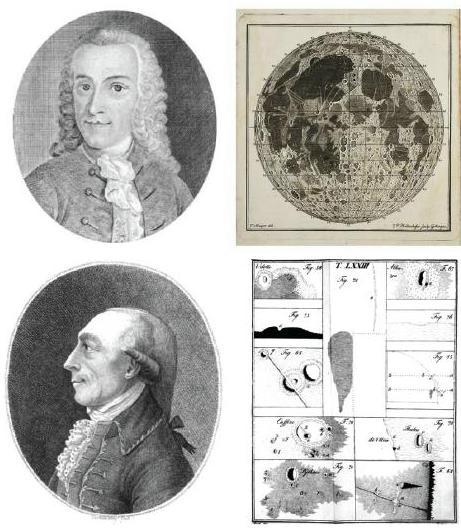
Figure 7 — Top row: J. T. Mayer and his orthographic lunar map, Bottom row: J.H. Schröter and lunar drawing example (all wikimedia)
Much the same applies to his planetary and solar work. These included his firm establishment that Venus has a dense atmosphere, and detection of the phase anomaly on Venus, known as the Schröter effect, referring to the discrepancy between the predicted and observed dates of dichotomy, as well as his efforts to determine the rotation period of both Mercury and Venus, and his discovery of solar granulation and details of sunspot umbrae (Darling, 2015b). Schröter’s pioneering efforts at comparative studies of the Moon and major planets preceded what would later become the sub-discipline of planetology as endeavoured a century later by Percival Lowell.
Volcanism and Selenites
In common with many of his contemporaries, Schröter became deeply interested, one might say obsessed, with the question of whether lunar craters were formed through volcanism, and whether the Moon had an atmosphere and might indeed be inhabited. The question of the origins of lunar craters no doubt began as soon as Galileo first observed them and adapted the term from the Greek name for vessel. Over the centuries at least three competing theories were advanced for the origin of craters: volcanic eruptions, meteoric impacts, and a most unlikely notion suggesting glacial action of sorts. In the 17th and 18th centuries, astronomers were fiercely divided over the issue of volcanic versus impact origins, as well as whether there was water and air on the Moon (Sheehan and Dobbins, 2001, Darling, 2015a). The latter two, of course, would have implications with respect to possible lunar life.
December / décembre 2015 JRASC | Promoting Astronomy in Canada 256
None others than such luminaries as Hevelius, William Herschel, and Isaac Newton before him, were convinced that not only the Moon but also the Sun and other planets were inhabited by intelligent beings (Baum, 2007, Darling, 2015a). Although such notions were by no means universally shared, Schröter most certainly entertained them. As David Darling (2015b) put it, “Schröter was an enthusiastic pluralist who wrote that he was fully convinced that every celestial body may be so arranged physically by the Almighty as to be filled with living creature….”
He also claimed to have detected an atmosphere on other planets he thought were inhabited, and attributed what he perceived as colour changes on the Moon to cultivated lands. It is perhaps important at this point to emphasize that most scientists and scholars of that era had strong religious convictions and were sure that the Almighty would not have created anything in the Universe without purpose. As a result, belief in pluralism or conviction in multiplicity of inhabited worlds was almost universal among Schröter and his contemporaries (Darling 2015c; Sheehan and Baum, 1995). Once again, a parallel can be drawn here and a century later, when enthusiasm, indeed conviction, for the plurality of inhabited worlds reached a peak of sorts with Percival Lowell, Camille Flammarion, Giovanni Schiaparelli, Richard Proctor, and other Mars enthusiasts of the Victorian era, only to be defused again by scientific reality in the 20th century (Teitel, 2011).
It is noteworthy that both ideas, namely that most craters are volcanic in origin and that, despite its all-but-nonexistent atmosphere, the Moon might still harbour some form of life, persisted into the 1960s. The volcanic origin of craters, so eloquently proposed by English amateurs James Nasmyth (1808-1890) and James Carpenter (1840-1899) in 1874, held sway for nearly a century (Nasmyth and Carpenter, 1874). Their “fountain model” of volcanic eruption, adapted to the largely airless Moon and its lower-than-Earth gravity, had great appeal (Koeberl, 2001) as it seemingly explained both lunar crater walls and central peaks (Figure 8). Since the art of high-resolution astronomical photography was not yet perfected, Nasmyth and Carpenter made stunning plaster-of-Paris models of lunar features based on detailed visual observations (Figure 8). Although by mid-20th century the pendulum had largely swung in favour of the impact hypothesis, several noted authors, including V.A. Firsoff (1912–1981) (Firsoff, 1959, p. 61), Sir Patrick Moore (1923–2012) (Moore, 1963, p. 106), and even some professional scientists (Simpson, 1966), still favoured a largely volcanic origin of lunar craters.
Figure 8 — Top: Nasmyth and Carpenter fountain model of lunar crater formation (Coventry and Warwickshire Astronomical Society, 1993). Bottom: Rendition of the crater Copernicus by James Carpenter (1874)
Likewise, and no doubt inspired by Percival Lowell’s notions about Mars and William H. Pickering’s (1858–1938) rather outlandish theories about plant and insect life on the Moon (Darling, 2015C), Firsoff concludes as late as 1959: “To sum up, there does not seem to be any sufficient reason why plants, even of a highly organized type, should be unable to exist on the Moon, though probably only in isolated oases of life, the highlands being almost entirely barren, as they appear to be on Mars” (Firsoff, 1959, p.178).
Perhaps the most notorious 19th-century advocate for intelligent life on the Moon, as well as on other planets including Venus, was Bavarian Franz von Paula Gruithuisen (1774–1852) (Baum, 2007). An ardent admirer of Schröter’s,
December / décembre 2015 JRASC | Promoting Astronomy in Canada 257
Gruithuisen acquired several of Fraunhofer’s superbly crafted achromatic refractors ideally suited for lunar and planetary observations. Fascinated by Schröter’s observations of several rilles (grooves or clefts) in certain regions of the Moon, he proceeded to study then in great detail, believing them to be cities or great monuments built by intelligent Selenites! As a result of such claims and notwithstanding the fact that he was an astute observer of both the Moon and the planets, Gruithuisen is given little credit for his original work and findings. Among other things, he was one of the first to suggest that lunar craters are impact features and to note the bright regions at the poles of Venus, which he thought were polar caps as on Mars. As noted historian of astronomy Richard Baum describes him: “…Gruithuisen was an obsessive pluralist… [and] carried his interest into practice and went in search of life on other worlds” (Baum, 2007, p. 170). After observing the illusive Ashen Light on Venus, his imaginings went beyond the pale, attributing the phenomenon to a celebratory festival by the planet’s inhabitants (Sheehan and Brasch, 2013).
References
- Baum, R. (2007) The Haunted Observatory, Prometheus Books, Amherst, NY, USA
- Darling, D. (2015a) www.daviddarling.info/encyclopedia/H/HerschelW.html
- Darling, D. (2015b) www.daviddarling.info/encyclopedia/S/Schroter.html
- Darling, D. (2015c) www.daviddarling.info/encyclopedia/M/Moonlife.html
- Digiplanet.com (2015) Aerial telescope www.digplanet.com/wiki/Aerial_telescope
- Firsoff, V.A. (1959) The Strange World of the Moon. An Enquiry into Lunar Physics. Hutchison & Co. Ltd, London
- Fresa, A. (1943) La Luna, Scuola Tipografica, Milan, Italy
- Hockey, T.A. (1986) The Book of the Moon, Prentice Hall Press, New York, USA
- Koeberl, C. (2001) Craters on the Moon from Galileo to Wegener: a short history of the impact hypothesis and implications for the study of terrestrial impact craters, Earth, Moon and Planets, 85-86, 209-224.
- Kopal, Z. and Carder, R.W. (1974) Mapping of the Moon, Past and Present, R. Reidel Publishing Company, Dordrecht, Holland
- Learner, R. (1981) Astronomy Through the Telescope, Van Nostrand Reinhold, Co., New York, USA
- Lee, J.J. (2014) http://news.nationalgeographic.com/news/2014/04/140413-total-lunar-eclipse-myths-space-culturescience/
- Moore, P. (1963) Survey of the Moon, Eyre & Spottiswoode, Ltd., London, UK
- Nasmyth, J.H. and Carpenter, J. (1874) The Moon: Considered as a Planet, a World and a Satellite, John Murray, London, UK
- Ré, P. First Lunar Maps http://astrosurf.com/re
- Sheehan, W. and Baum, R. (1995) Observation and inference: Johann Hieronymus
- Schroeter, 1745-1816, J. Brit. Astron. Assoc. 105, 4, 171-175
- Sheehan, W. and Brasch, K. (2013) The “Loch Ness” of Venus, SkyNews, 19, 36-37
- Sheehan, W. P. and Dobbins, T. A. (2001) Epic Moon, Willmann-Bell, Inc., Richmond, VA
- Simpson, J.F. (1966) Additional evidence for the volcanic origin of lunar and Martian craters, Earth and Planetary Science Letters, 1, 132-134.
- Sci. ESA (1999)
- http://sci.esa.int/cassini-huygens/12465-jean-dominique-cassini-andchristiaan-huygens/
- Sobel, D. (1999) Galileo’s Daughter, Walker Publishing, Inc., New York, USA
- Tarbuck, E.J. and Lutgens, F.K. (2011) Earth: an introduction to physical geology, Prentice Hall, New Jersey, USA
- Teitel, A.S. (2011) http://amyshirateitel.com/2011/02/13/mars-avictorian-sensation
- Whitaker, E.A. (1989) Selenography in the seventeenth century, chapter 8 in: The General History of Astronomy, vol. 2, Planetary astronomy from the Renaissance to the rise of astrophysics, René Taton and Curtis Wilson (Eds.), Cambridge University Press, UK
- Wikipedia (2015a) List of Lunar Deities http://en.wikipedia.org/wiki/List_of_lunar_deities
- Wikipedia (2015b) Rosh Chodesh http://en.wikipedia.org/wiki/Rosh_Chodesh
- Wikipedia (2015c) Allah as Moon-god http://en.wikipedia.org/wiki/Allah_as_Moon-god
- Wikipedia (2015d) Refracting Telescopes http://en.wikipedia.org/wiki/Refracting_telescope#Keplerian_Telescope
- Wikipedia (2015e) Eyepiece http://en.wikipedia.org/wiki/Eyepiece
- Wikipedia (2015f) Giovanni Domenico Cassini http://en.wikipedia.org/
- wiki/Giovanni_Domenico_Cassini
- Wikipedia (2015g) Johann Heinrich Mädler
December / décembre 2015 JRASC | Promoting Astronomy in Canada 258
Outreach || Flagstaff || Photos || Articles || Observing Sites || Weather
Coordinated Universal Time || National Weather Service
info@coconinoastro.org

